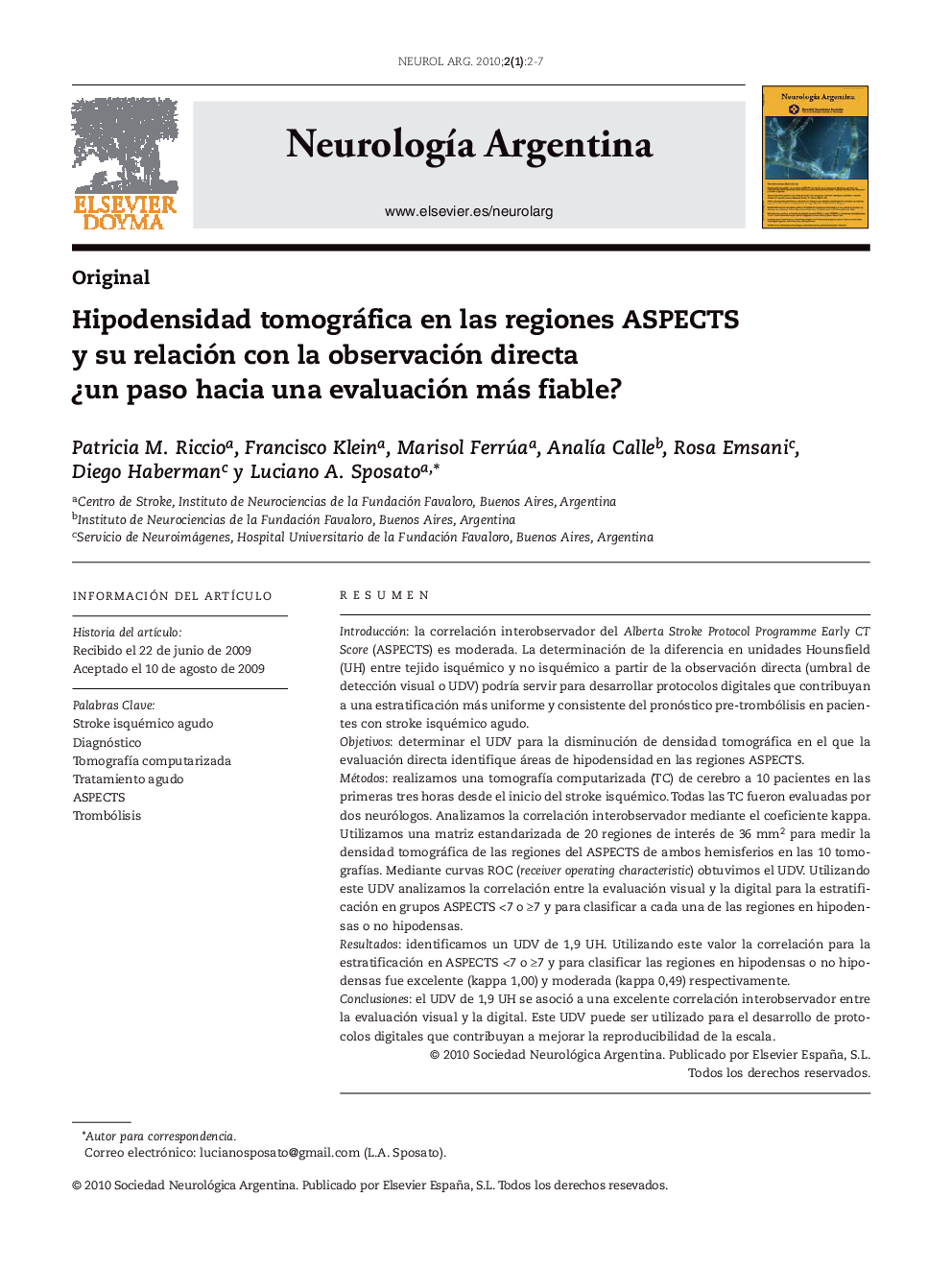| Article ID | Journal | Published Year | Pages | File Type |
|---|---|---|---|---|
| 3076977 | Neurología Argentina | 2010 | 6 Pages |
ResumenIntroducciónla correlación interobservador del Alberta Stroke Protocol Programme Early CT Score (ASPECTS) es moderada. La determinación de la diferencia en unidades Hounsfield (UH) entre tejido isquémico y no isquémico a partir de la observación directa (umbral de detección visual o UDV) podría servir para desarrollar protocolos digitales que contribuyan a una estratificación más uniforme y consistente del pronóstico pre-trombólisis en pacientes con stroke isquémico agudo.Objetivosdeterminar el UDV para la disminución de densidad tomográfica en el que la evaluación directa identifique áreas de hipodensidad en las regiones ASPECTS.Métodosrealizamos una tomografía computarizada (TC) de cerebro a 10 pacientes en las primeras tres horas desde el inicio del stroke isquémico. Todas las TC fueron evaluadas por dos neurólogos. Analizamos la correlación interobservador mediante el coeficiente kappa. Utilizamos una matriz estandarizada de 20 regiones de interés de 36 mm2 para medir la densidad tomográfica de las regiones del ASPECTS de ambos hemisferios en las 10 tomografías. Mediante curvas ROC (receiver operating characteristic) obtuvimos el UDV. Utilizando este UDV analizamos la correlación entre la evaluación visual y la digital para la estratificación en grupos ASPECTS <7 o ≥7 y para clasificar a cada una de las regiones en hipodensas o no hipodensas.Resultadosidentificamos un UDV de 1,9 UH. Utilizando este valor la correlación para la estratificación en ASPECTS <7 o ≥7 y para clasificar las regiones en hipodensas o no hipodensas fue excelente (kappa 1,00) y moderada (kappa 0,49) respectivamente.Conclusionesel UDV de 1,9 UH se asoció a una excelente correlación interobservador entre la evaluación visual y la digital. Este UDV puede ser utilizado para el desarrollo de protocolos digitales que contribuyan a mejorar la reproducibilidad de la escala.
BackgroundSome studies have yielded a moderate to poor agreement between observers when using the Alberta Stroke Protocol Programme Early CT Score (ASPECTS). Identifying a threshold for tomographic density decline at which visual assessment identifies areas of hypoattenuation on ASPECTS regions could be used to develop digital protocols for achieving a more homogeneous stratification of ASPECTS scores in the hyperacute ischemic stroke setting.ObjectiveTo identify the threshold for tomographic density decline at which visual assessment identifies areas of hypoattenuation on ASPECTS regions.MethodsA non contrast computed tomography (CT) scan of the brain was performed in 10 patients within 3 hours of acute ischemic stroke onset. All CT scans were evaluated by 2 neurologists trained in using ASPECTS. The only clinical information given to them was symptoms’ side. Results of ASPECTS scores were dichotomized into <7 or ≥7. Interrater variability was tested using the kappa coefficient. We measured the tomographic density of the 10 ASPECTS regions on the ischemic and nonischemic hemispheres. A standardized matrix consisting of 10 regions of interest of 36 mm2 placed at the core of the ASPECTS regions was used for this purpose. The neuroradiologist was blinded to patient symptoms. We used ROC (receiving operating characteristic) curves for establishing the threshold for achieving the best correlation between the digitally measured and visually assessed ASPECTS scores. We assessed Interrater variability between the direct visual observation and the digital evaluations for defining areas of hypoattenuation and for classifying patients into groups of ASPECTS <7 or ≥7.ResultsWe identified a threshold of 1.9 Hounsfield units (HU) which best correlated to the visual observations. When this threshold was used, the correlation between visual and digital assessments was moderate (Kappa 0.49) for defining the presence or absence of hypoattenuation, and excellent (Kappa 1.00) for classifying patients into groups of ASPECTS <7 or ≥7.ConclusionsWe found a threshold of 1.9 HU for identifying ischemic ASPECTS regions. This difference in attenuation could be used for developing a digital grading protocol aimed at reducing interobserver variability when assessing CT scans in the hyperacute ischemic stroke setting.
